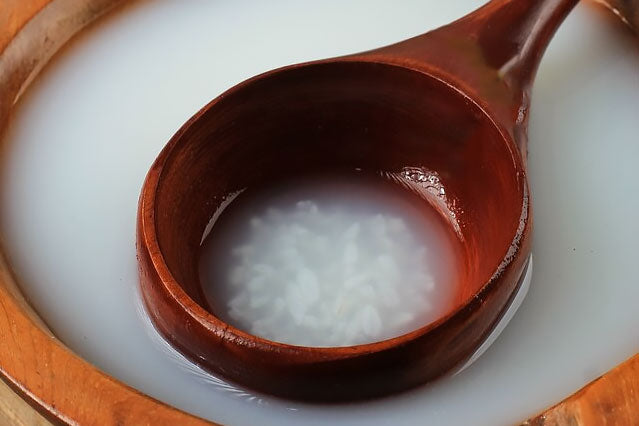Sikhye: Traditional Korean Sweet Rice Punch Drink

Sikhye is a delightful traditional Korean beverage made from fermented rice. It holds a special place in Korean cuisine and culture, known for its unique taste and health benefits. In this article, we will delve into the origins of sikhye, explore its ingredients and preparation process, discuss its cultural significance, and highlight some of its potential health benefits.
The Origins of Sikhye
Sikhye has a rich history that dates back to ancient times in Korea. It is believed to have originated during the Three Kingdoms period, which lasted from 57 BCE to 668 CE. The beverage was traditionally consumed during celebratory occasions, religious ceremonies, and important events.
It was initially consumed as a medicinal drink and was prepared by fermenting rice. Over time, it evolved into a popular sweet beverage enjoyed by people of all ages.
Ingredients and Preparation Process
Sikhye is primarily made from rice, malt, and water. Additional ingredients like sugar, pine nuts, and ginger can be added to enhance the flavor. The preparation process involves several steps:
- Soaking: Rice is soaked in water for a certain period to soften it.
- Steaming: The soaked rice is then steamed until it becomes fully cooked and soft.
- Cooling: The steamed rice is allowed to cool down to room temperature.
- Mixing: Malt is added to the cooled rice and mixed thoroughly.
- Fermentation: The rice and malt mixture is left to ferment for a specific duration, allowing the natural fermentation process to take place.
- Sweetening: Sugar is added to the fermented mixture to achieve the desired level of sweetness.
- Flavoring: Optional ingredients like pine nuts or ginger can be added to enhance the taste.
- Chilling: The prepared sikhye is then refrigerated to serve it chilled and refreshing.

Typically made from cooked rice, water, and malt. The cooked rice is soaked in water and mixed with malt powder or nuruk (a fermentation starter). The mixture is then left to ferment for several hours, allowing the enzymes in the malt to break down the starches in the rice and convert them into sugars. After fermentation, the liquid is strained, and additional sweeteners such as sugar or honey may be added to enhance the taste.
The strained liquid is then chilled and served cold, often in traditional Korean brassware bowls called bangjja. Sikhye has a slightly sweet and refreshing flavor with a hint of rice and malt. It is often garnished with pine nuts or jujubes for added texture and visual appeal.
Cultural Significance of Sikhye
Sikhye holds great cultural significance in Korean society. It is commonly served during festive occasions, such as weddings, birthdays, and traditional holidays like Seollal (Lunar New Year) and Chuseok (Harvest Festival). Sikhye is commonly served as a dessert or a palate cleanser after a meal. The beverage symbolizes good fortune, happiness, and prosperity. It is also often offered to ancestors during ancestral memorial rites, reflecting the deep-rooted respect for ancestors in Korean culture.
Traditional Variations of Korean Rice Punch
Korean rice punch has various traditional variations that add unique flavors and aromas to the beverage. Some popular variations include:
- Yuja Sikhye: This variation incorporates yuja (citron) fruit, which adds a citrusy and refreshing taste to the punch.
- Omija Sikhye: Omija, also known as "five-flavored berry," is used to create a punch with a complex flavor profile that combines sweetness, tartness, and hints of other flavors.
- Ginger Sikhye: By adding ginger to the punch, a subtle spiciness and warmth are infused into the beverage.
- Cinnamon Sikhye: Cinnamon lends a delightful and aromatic twist to the traditional rice punch, enhancing its overall flavor.

Serving and Enjoying Korean Rice Punch
Korean rice drink is traditionally served cold in small bowls or cups. It is a common sight at Korean celebrations and can be found in many traditional Korean restaurants. The punch is often paired with traditional Korean snacks or enjoyed on its own as a refreshing and hydrating beverage.
Health Benefits of Sikhye
Apart from its delightful taste, sikhye also offers some potential health benefits. Here are a few notable ones:
- Digestive Aid: Sikhye contains probiotics and enzymes that can aid digestion and promote a healthy gut.
- Hydration: With its high water content, sikhye helps to hydrate the body and replenish electrolytes.
- Nutritional Value: Sikhye is a good source of vitamins, minerals, and carbohydrates, providing a quick energy boost.
- Stress Relief: The soothing taste and aroma of sikhye can help reduce stress and promote relaxation.
- Antioxidant Properties: Some of the ingredients in sikhye, such as malt and ginger, possess antioxidant properties that can help combat oxidative stress.
Conclusion
Sikhye is a cherished beverage in Korean cuisine, offering a delightful blend of flavors and a connection to ancient traditions. Its unique preparation process and cultural significance make it a captivating part of Korean cuisine. Whether enjoyed during celebratory occasions or as a refreshing drink on a hot summer day, sikhye brings a touch of sweetness and tradition to every sip. Its health benefits, including aiding digestion and providing hydration, further add to its appeal. So, the next time you're in search of a flavorful and refreshing drink, consider trying Korean rice drink. Its sweet and tangy taste makes it a truly special beverage that captures the essence of Korea.
FAQs
Is sikhye alcoholic?
No, sikhye is a non-alcoholic beverage made from fermented rice. It has a slight hint of fermentation but contains negligible alcohol content.
Can sikhye be made at home?
Yes, sikhye can be made at home using simple ingredients like rice, malt, and sugar. The fermentation process may take a few days, but it is a rewarding and enjoyable experience.
Is sikhye suitable for vegetarians and vegans?
Yes, sikhye is typically vegetarian and vegan-friendly as it primarily consists of rice, water, malt, and optional flavorings like ginger or pine nuts. However, it's always best to check the ingredients to ensure no animal-derived products are used.
Can sikhye be stored for a long time?
Sikhye is best consumed within a few days of preparation as it retains its freshness and flavor. While it can be refrigerated for a short period, the taste and quality may deteriorate over time.
Are there any regional variations of sikhye?
Yes, different regions of Korea may have their own variations of sikhye, incorporating local ingredients or slight differences in the preparation process. These variations add to the diversity and uniqueness of sikhye across the country.






